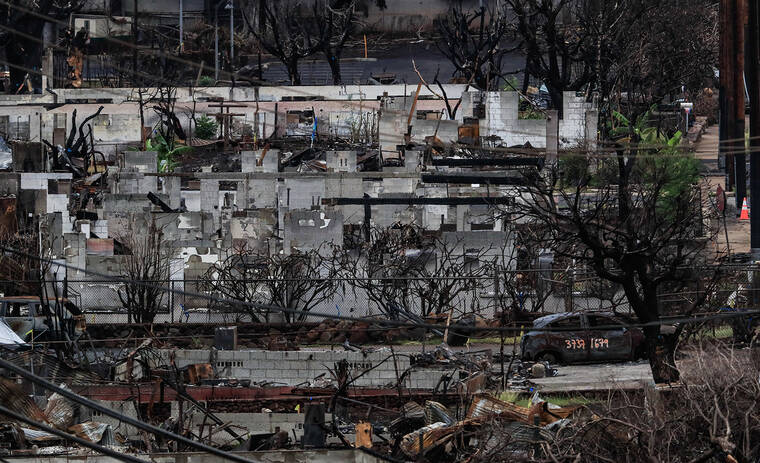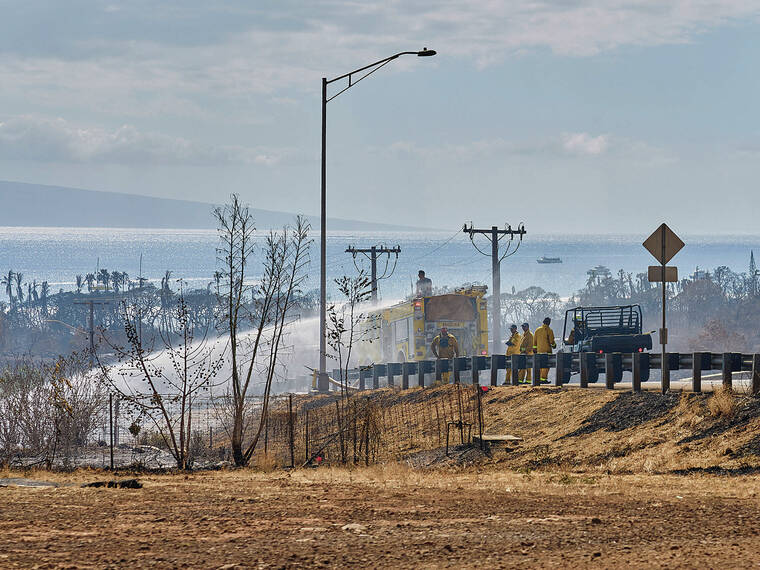Editorial: ATF report basis for improvement

JAMM AQUINO / JAQUINO@STARADVERTISER.COM
Remnants of houses and debris are seen in the burn zone on Dec. 1 in Lahaina.
A crucial report from the Maui Fire Department and the U.S. Bureau of Alcohol, Tobacco, Firearms and Explosives (ATF) concludes that the deadly Lahaina fire on Aug. 8, 2023, had one cause: Hawaiian Electric’s (HECO’s) operation of power lines vulnerable to toppling under high winds, and its failure to keep power cut on broken power lines that fell in an area surrounded by overgrown, tinder-dry grass and brush, sparking a fire that would burn Lahaina largely to the ground.
A determinant factor in the fire’s spread, once sparked, was overgrown open land, the report also concludes. This included land owned by Kamehameha Schools (KS) that earlier had been identified as a fire risk. KS had been ordered to create a fire break in the area, but investigators found that it had not been sufficiently maintained.
The report doesn’t assign liability, but it clearly provides backing for a finding that HECO and KS are most responsible for the fire. The report also explicitly absolves Maui firefighters from responsibility, detailing that they responded to an early-morning fire sparked by HECO, followed all procedures expected of them in fighting the fire, and were not responsible for the resparking of the blaze hours later under hurricane-level winds.
The assignment of cause and effect is a landmark step. Next, the road forward splits into two paths: Resolution of legal claims for damages; and utilization of the facts revealed to protect against future risks — both matters of great concern to the state as a whole.
A global settlement urged by the state is at stake. The proposal creates a settlement fund of about $4 billion, and rightly establishes preference for payouts to individual fire victims.
The settlement also benefits HECO and KS, which have accepted responsibility for the fire damage, by providing a single path to resolution with all claimants, and establishing terms that will not damage them irreparably.
Don't miss out on what's happening!
Stay in touch with breaking news, as it happens, conveniently in your email inbox. It's FREE!
HECO, the state’s largest utility, literally powers the islands, with the exception of Kauai. It has agreed to contribute roughly half of the $4 billion settlement to resolve Maui wildfire lawsuits, an amount that is currently higher than its entire market capitalization.
KS, the largest landowner in the state, is an historic trust established by Princess Bernice Pauahi Bishop to educate and support Hawaiians. In mediation, KS’s share of the settlement was set at $872.5 million.
The biggest potential pitfall continues to be insurers’ efforts to sue for “subrogation” — repayment of their settlements with individual victims by those judged liable.
If separate subrogation suits are allowed, it would scuttle the global settlement, potentially reduce and delay payouts to victims as agreed to in the settlement — which would be very unfortunate — and expose HECO and KS to further, unsettled risk of liability.
The insurers’ effort was denied by the Maui Circuit Court with an order asserting state courts’ authority to consolidate claims. The Hawaii Supreme Court is now expediting consideration of the issue, to clarify the settlement’s legal status.
However, the insurers have also taken their claim to federal court — a move criticized by Gov. Josh Green. “It is disappointing,” he said Friday, “that mainland insurance companies continue to demonstrate their contempt for the people of Hawaii as they put profits ahead of people.”
The federal court filing, made days before Wednesday’s release of the Maui/ATF report, has driven speculation that the report, with its assignment of cause to HECO and Kamehameha Schools, could bolster the insurers’ case with the feds.
Green’s counter to that: “The ATF report will provide guidance to better prepare the state for future severe weather events. It does not impact the global settlement, since all parties were well aware of the facts that led to the Lahaina wildfires.”
The U.S. District Court should respect the jurisdiction of Hawaii courts in this matter. A global settlement is in the best interest of fire victims, Hawaii institutions and the state itself, as Hawaii could face economic damage and a deterioration of services should the state courts be stripped of their ability to manage and consolidate a case of this magnitude.
The highest value of the ATF report, as opined by the governor, is in providing background for a broad safety and preparation effort. Hawaii must now incorporate each of these findings into better emergency response plans, and sharper actions, that will prevent a repeat of the devastation in Lahaina.
It’s essential that both within each county and across the state, preparations are swiftly made to predict risky conditions and mitigate them, that coordination and communication among emergency responders are planned for and enabled. And critically, those responsible for warning the public, activating emergency response and carrying out this response under disastrous and life-threatening conditions must be fully trained, stay alert and be equipped to carry out this most essential public responsibility.





